GRAND RAPIDS, MICHIGAN (19 APRIL, 2021)
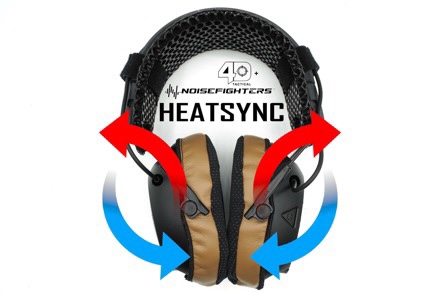
NOISEFIGHTERS and its development partner 4D TACTICAL today announces the public launch of the HEATSYNCTM sweat-wicking, form-fitting fabric ear pad cover for headsets. Heatsync addresses the #1 problem with over-the-ear headsets: in hot weather, there is internal sweat accumulation and excessive heat buildup. A form-fitting cover — made 100% in the U.S.A. from advanced materials including 4D Tactical’s NanoTech silver-embedded, antimicrobial, wicking fabric — is pulled tight over the headset’s existing ear pads. In use, the Heatsync draws perspiration out from the inside of the headset and helps cool the wearer through the evaporative process, while also eliminating the slimy feeling normally associated with pressing wet rubber ear pads against the head in hot weather.
“Teaching over 70 classes a year, I practically live in hearing protection. The comfort and protection Noisefighters products offer is second to none, and the new Heatsync has only made it better. Goodbye, sweaty earpro!” said Erik “Trek” Utrecht, owner of Michigan Defensive Firearms Institute (MDFI: https://trainmdfi.com). MDFI is a Michigan-based training company that trains over 1500 students annually with the goal of building responsibly-armed citizens that are confident and competent with their defensive tools.
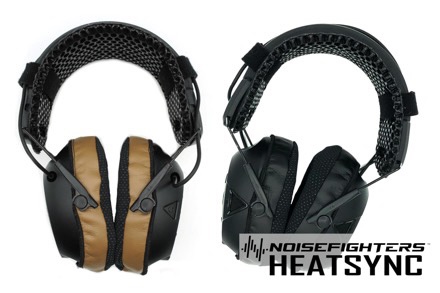
Photo showing the Noisefighters Heatsync in coyote brown and black colors installed on headsets, with Qore Performance IceVents Ventilated Headbands additionally installed.
“After more than two years of development, I’m extremely excited to get Heatsync out into the world. Being able to partner with 4D Tactical on this product is a dream come true, as their leadership team brings decades of experience to the table and a standing in the industry that’s really unmatched,” said Neal Brace, inventor of the product and owner of Noisefighters. “Heatsync is, to my knowledge, the first viable answer to the problem that my customers have brought up time and time again: in hot weather, how does one stay cool, or at least comfortable, while wearing a headset that is designed to seal the noise out? The solution we came up with is tightly form fitting, keeps the ear cup cavity fully open for comfort, and ensures the noise seal is totally closed for safety. It doesn’t rely on electronics, just specially-engineered fabrics and a clever design.”
4D Tactical’s leadership team, including CEO Heidi Dennis and Vice President David Dennis, said in a statement that they were, “[…] very pleased to have had the opportunity to collaborate with Noisefighters. We feel the Heatsync product provides significant improvements to conventional headset ear seals. We hope this is just the beginning of our collaboration with Noisefighters.”
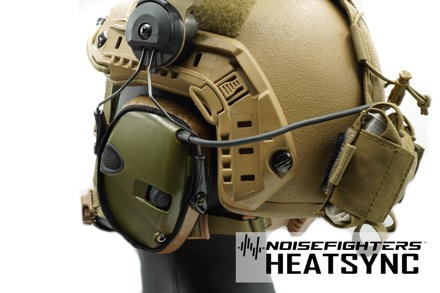
Photo showing the Noisefighters Heatsync in coyote brown installed on a headset and attached to a helmet.
Heatsync is a universal cover designed to fit every headset that uses the industry standard 4″ (102 mm) tall by 3″ (76 mm) wide oval or rectangular ear pads of thicknesses between 0.5″ (12.7mm) and 0.75″ (19mm). A stainless steel expanding spring is included to lock the Heatsync cover to the inside of each cup on the headset and keep the ear cup cavity open. The cover was tested and proven to fit all current headsets from Ops-Core®, Peltor®, Howard Leight®, Sordin®, Walker’s Game Ear®, and many brands of aviation headsets, as well. It may fit other headsets with slightly smaller, larger, or even fully circular ear pads with different thicknesses, as well, due to the stretchable fabric construction. Installation is very fast, easy, and reversible, with no evidence of the cover ever having been attached.
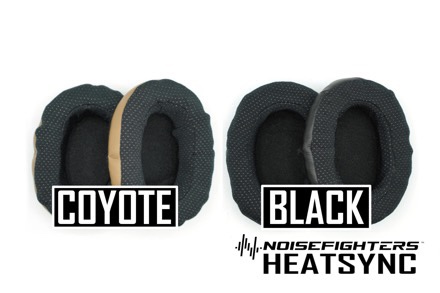
Photo showing the form-fitting nature of the Noisefighters Heatsync sweat-wicking fabric cover, shown in both coyote brown and black colors.
During extreme cold weather use, the cover additionally provides an insulative barrier between the freezing cold rubber ear pads and the user’s face. The Heatsync’s proprietary fabrics are also pleasing to the touch and add a noticeable amount of comfort versus rubber ear pads. The design is fully compatible with either foam-filled or gel-filled ear pads, and its highly-compliant fabric is a perfect fit with Noisefighters’ Sightlines gel-filled ear pads that feature a patented relief cut feature for glasses arms to pass through.
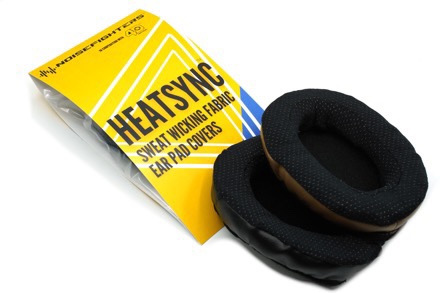
Photo showing both colors of the Noisefighters Heatsync with product packaging.
Heatsync is made in the U.S.A. and is fully Berry Amendment and TAA compliant.
Heatsync’s MSRP is $90, with product launch sale pricing set at $75. Noisefighters offers a discount program for LEO / MIL and veterans / EMS / FD / security professionals / defensive tactics instructors, with details available on its website on the FAQ page. Organizations looking to purchase in bulk can inquire about a volume discount.
Noisefighters has the Heatsync available for sale on its website and will soon make it available through its extensive, worldwide dealer network.
CONTACT:
Noisefighters
www.noisefighters.com team@noisefighters.com
616-226-3551
Instagram: @noisefighters


NOT FOR CURRENT GENERATION AMP HEADSETS!
I ordered these based on the news release published above and received them this morning. Watched the HEATSYNC Youtube video (more below) on how to install these on various manufacturers’ headsets, since no instructions (or even a link to the YT vid) are included with the covers.
The problem is they’ve tried to make these “one size fits all,” which is understandable, but at least in the case of currently shipping AMP headsets they not only do not fit, they CANNOT fit, unless you simply slide them over the installed earpieces.
1. The current AMP earpiece clips’ mounting pegs (which fit into depressions on the earpieces) are too short to accommodate the thickness of the HEATSYNC fabric between the clip and earpiece.
2. The “one size fits all” design covers the headset controls at the bottom of the left earpiece, which means they block the tactile responses necessary to actuate the switches.
3. Obviously you could simply slide the covers over the outside of the already-installed earpieces (as opposed to pinning them in place through the holes in the cover), but then run the risk of them falling off during ops.
4. f you simply slide these over the outside of the earpieces, it’s impossible to get the cover to lay flat on on the AMP earpiece, even when the included “expanding wires.” The resulting folds in the cover fabric irritate the human ear, which means wearing these for more than 30 minutes (for me at least) causes too much irritation and makes the covers not worth the trouble or expense. This issue also existed when I tried to mount the covers as described in the YT video.
I mentioned the Youtube video earlier. They show explicit instructions for fitting the covers on the AMP earpieces, and in their vid “successfully” install them. What they don’t show, however, is that since the AMP earpiece clip mounting pegs are sized to fit snugly as originally designed, when you add the thickness of the cover between the clip and earpiece the pegs are too short to reliably clip into the receiving depressions on the earpieces. The pegs will partially seat in the depressions, but the hold is very insecure and the earpieces soon snap free and dangle from the headband. Needless to say, this reduces hearing protection effectiveness! (Oh, and this also relieves the problem of the folds in the cover irritating your ears…)
My guess is these covers would probably work OK on other designs, but you may want to consider carefully if you’ve got a current AMP headset (I don’t know whether these covers will fit older AMP headsets, whch may or may not have longer earpiece clamp pegs).
Could this be “operator error” during installation. Of course. But in the immortal words of Adrian Monk, “I might be wrong, but I don’t think so.”